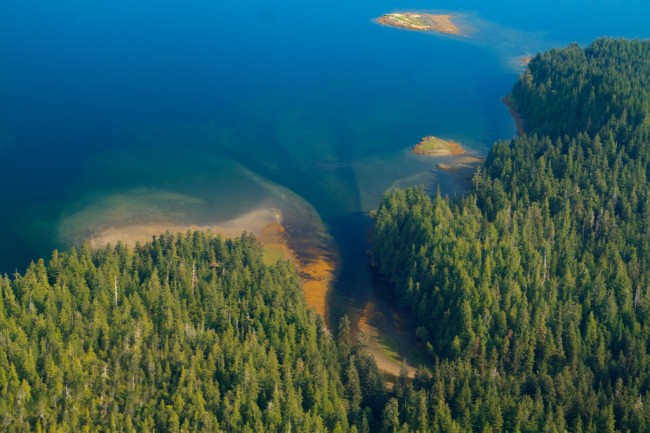
As conservationists celebrate 50 years since the passage of the Wilderness Act, a U.S. Forest Service proposal to make certain wilderness area regulations permanent has brought forth accusations that the agency is infringing on First Amendment rights. Nearly a third of the 17 million-acre Tongass National Forest in Southeast Alaska is designated wilderness.
The Forest Service has extended the public comment period on the regulations and chief Tom Tidwell issued a statement saying the regulations do not apply to news gathering activities. Two public media organizations in the Lower 48 disagree and are attempting to organize national opposition.
Forest Service officials say the regulations are based on the Wilderness Act of 1964. Regulations requiring commercial photographers and filmmakers to apply and pay for special use permits have been in effect for four years. Because the regulations expire next month, the Forest Service is proposing making them permanent.
Breaking news situations are exempt from the permitting requirement, however they have to meet the Forest Service’s definition of breaking news. That aside, permits are required and might come with a cost. The Forest Service’s acting wilderness director Liz Close, clarified the regulations to The Oregonian, saying that reporting in support of “wilderness characteristics” would be permitted. The qualification of such reporting is left up to forest supervisors.
And that is particularly troublesome for news people: A government entity determining which stories are worthwhile and don’t require a paid permit, or charging for access on stories that don’t support their mission.
That became the issue for Idaho Public Television a few years ago, shortly after the regulations were implemented. General Manager Ron Pisaneschi says for years their filmmakers were allowed to go into wilderness areas without permits or pre-approval. Filmmakers showed up to document conservation workers in 2010, and were told they needed a permit. They applied and were then told they would have to pay for the permit.
The decision was eventually reversed, but Pisaneschi says it forced the cancellation of the production. In that case, Pisaneschi says the Forest Service official determined it was a commercial use because the filmmakers were not volunteering their time.
“We are licensed as a non-commercial television station by the FCC, the IRS says we are a non-profit entity,” Pisaneschi says. “To make matters even more non-commercial in nature, we are a state agency, we are a state entity, but none of those seem to be sufficient as the guidelines are written currently.”
Pisaneschi says the regulations define news too narrowly, define commercial use too broadly and are open to interpretation.
“It may be fine if the forest is on fire at that given moment, that seems to be an acceptable thing to film,” Pisaneschi says. “But if you’re going to do a long-form documentary about the impact of drought on forest health, that’s not considered breaking news and you would need to get a permit for that.”
Forest Service officials in Alaska did not respond to requests for comment, so it’s unknown how many applications for permits in the state have been submitted and if any have been denied.
Idaho Public Television and Oregon Public Broadcasting have been fighting the regulations for some time now. OPB President and CEO Steve Bass sent out an email Wednesday to public television general managers across the nation – including KTOO’s General Manager Bill Legere – asking them to join the effort.
Bass wrote that the rules are a barrier for public media and create a system where print journalists have unrestricted access to Forest Service wilderness lands, but multimedia journalists must be permitted.
Conservationist and commercial wildlife photographer Adam Andis says the regulations seem less strict than he would have interpreted from the Wilderness Act.
“As a professional photographer I would rather see a stricter limitation that makes it harder for me to take pictures in those areas than to see those wilderness areas lost,” he says.
Andis is on the boards of the National Wilderness Stewardship Alliance and the Alaska Wilderness Recreation and Tourism Association. He says he’s never been required to get a permit for his commercial photography. He said that he’s filmed a documentary in a wilderness area; a Forest Service official agreed to waive the permit fee because it promoted “wilderness character.”
“It’s not necessarily that they’re trying to make value calls on who gets the right to be there and who doesn’t,” Andis says. “Their job is to make sure that there isn’t this mass of people all using this resource in an unsustainable way, so they have to figure out some way to put limits on it.”
Ultimately, there are a few key things that Andis, the conservationist, and Pisaneschi, the public television manager, agree on. Both think that the Forest Service should be more nuanced in their approach to permitting–two people with a camera and backpack will have far less impact on a wilderness area than a full Hollywood crew. Both also agree that allowing the untamed wilderness to be documented and shared promotes the goals of the Wilderness Act.
The biggest difference between the two is that Andis wants the wilderness protected at any cost, even if it means restricting press access, and Pisaneschi sees documenting the wilderness as one of the best ways to protect it.
